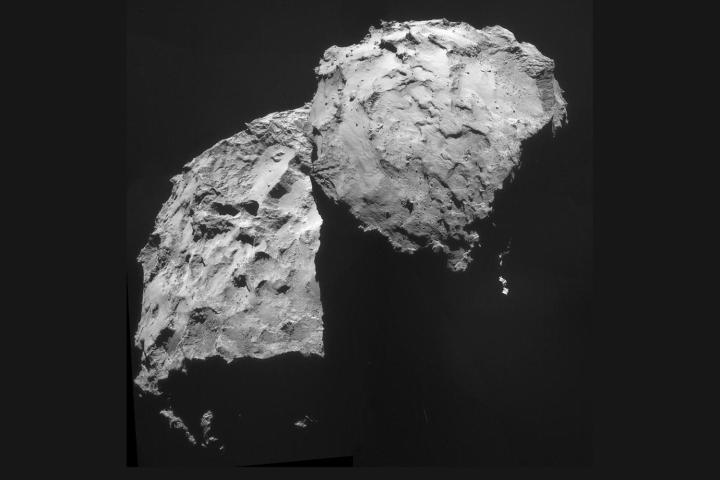
There were cheers and celebration across the Internet and in European and United States space agencies this morning with news that a small robotic lander had, for the first time, successfully touched down on a comet. Even Captain Kirk sent his best wishes.
However, after some check-out time for the landing at the ESA flight control center, a spokesman said all had not gone as planned with the comet lander known as Philae (pronounced “fee-lay”).
Preliminary indications suggest the lander’s harpoon-like grappling hooks may not have fired as planned and a small rocket on top of the lander designed to help pin Philae to the comet’s surface did not activate (gravity on a comet is very, very weak, contrary to what you see in the movies). But the bottom line is that the lander did reach the comet, and while it’s exact status is is not exactly known, it has been sending back telemetry indicating it’s on the surface in some manner.
Hours after the landing, ESA officials said they were continuing to receive data from Philae, but the information may be indicating the lander touched down, bounced up, and landed again. Officials said the probe’s landing gear was designed for such an event and they expect the probe is safe and should be able to continue with its mission. The probe approached the comet literally at walking speed – or slower. The Rosetta mothership is currently behind the comet as part of its slow orbit, so they expect to have more data – and possibly some images – when the two spacecrafts’ radios link back up in several hours.
Regardless of the bouncing space probe’s ultimate position on the comet, it’s a monumental triumph for space exploration in general and the European Space Agency in particular, which designed and managed the 10-year Rosetta mission. NASA also took part, bundling three science packages aboard the spacecraft, which traveled billions of miles in hibernation before arriving at Comet Churyumov-Gerasimenko, better known as Comet 67P, this past August. The comet is currently located in the space between the orbits of Mars and Jupiter, about 317 million miles, or 28 light minutes, from Earth.
Upon arrival at Comet 67P, the spacecraft “woke up” and all systems checked out. It also sent back some amazing close-up images of the comet, since it is orbiting less than 20 miles away from the surface. Comet 67P is about 3 miles long at its widest point, and vaguely resembles the shape of a peanut, or perhaps a lumpy rubber duck.
With the Rosetta spacecraft slowly orbiting the comet as it sped towards the sun at over 41,000 miles an hour, a second, smaller craft called Philae detached from the Rosetta mothership and slowly descended to the comet surface today. Just after 8:30 a.m., signals from Rosetta and Philae, which take six hours to reach Earth at the speed of light, confirmed Philae’s touchdown on the surface. Cameras aboard Rosetta were even able to snap a photo of the plucky Philae lander as it slowly drifted towards the comet.
Cheers and hugs erupted with the initial signals that the Philae lander was on the surface of Comet 67P.
“Science fiction has become science fact today. Hollywood is good, but Rosetta is better,” one ESA official said during a news conference following confirmation of the landing.
Jim Green from NASA was also effusive in his praise, and gave a strong indication of NASA’s intentions for the future. “How audacious, how exciting, how unbelievable to dare to land on a comet!” he yelled to applause at the news conference. “The solar system is mankind’s. Let’s take it. It’s ours,” he said. “I truly believe that a single planet species will not survive for long.”
It wasn’t that long ago that comets were considered a supernatural force, a harbinger of bad fortune, a mystery from an unknowable universe. Over time, a more scientific analysis revealed them to be essentially big dirty snowballs, remnants from a time when our solar system first formed almost 5 billion years ago.
If the Philae lander is able to get a grip on the surface of the comet, the plan is to punch a drill into it to a depth of about 9 inches and then analyze the material. Many scientists think that much of the liquid water on earth (and other planets) arrived when comets smashed into planets during the early years of the solar system, when planets were constantly bombarded with objects from space.
Some scientists also theorize that comets may have brought the first building blocks of life to Earth in the form of complex molecules beyond H2O and rocky minerals, and those molecules went on to form the basis of the first terrestrial lifeforms. The Rosetta mission was partially designed to see if that theory is correct.
If it is, millennia from now, humankind may look back on the Rosetta mission as perhaps one of the most important space missions in history. They even made a short movie about that vision called Ambition, featuring Aiden Gillen, that guy who plays Little Finger on Game of Thrones. It’s pretty impressive in it’s own right. Watch it below.
We will update this story as more information from ESA become available.


